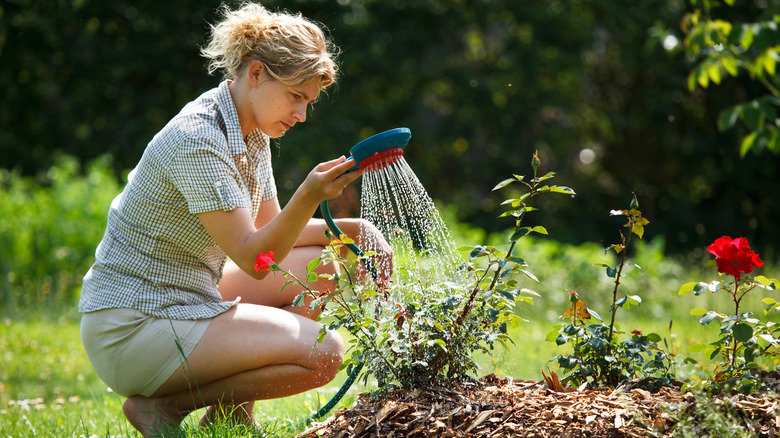How To Take Care Of Your Prize Roses In Extreme Heat
Cherished as the national flower, the rose (Rosa rubiginosa) is an ever-favorite among gardeners seeking to grow hardy plants with exquisitely-shaded blooms and fragrant aromas. While generally tolerant of temperatures up to 85 degrees Fahrenheit, your prized queen of flowers begins to wilt and droop when exposed to scorching heat. This is because as the season grows warmer, rose plants experience higher transpiration levels, where their leaves lose water faster than usual. They may eventually turn dormant and stop growing as a self-defense mechanism if temperatures don't relent.
However, saving your rosy blossoms from extreme heat stress is easy. Watering them deeply at least twice a week during the summer will help beat all transpiration woes. Regularly mulching the soil will improve water retention, ensuring your blossoms remain colorful throughout high temperatures. Moreover, providing partial shade can be helpful in arid climates. But not much can be done if a rose plant stops photosynthesizing in its dormant stage. At best, you can wait for the season to cool down and hope your plant survives.
Protecting roses from transpiration
Soaring temperatures hasten the process of evaporation and reduce the amount of water available to the rose plant's tissues — at times, going down to a mere 25%. This results in smaller blooms and paper-thin petals, as the rose bush is focused on keeping its foliage alive. In the worst cases, excessive transpiration may prevent the old leaves from cooling, causing them to turn yellow. Such scorched rose plants usually showcase brown leafy layers on top.
Such desiccation damage can be dealt with by providing your floral gems with adequate shade during the day's most intense heat. White or silver-colored fabric umbrellas work best for small rose plant collections. You can also use your dark-hued umbrellas, provided they are covered with aluminum foil, reflecting away sunlight, preventing any heat build-up.
But if you are growing a massive rose bed, consider installing a permanent shade fixture made of PVC pipes and a light cloth. Also, don't prune dead leaves yet, as they offer coverage for new growth. As a long-term measure, you can also consider switching your rose varieties for those with starch-rich petals, as this ensures better water retention.
Caring for roses going dormant
When temperatures soar beyond 95 degrees Fahrenheit, the enzymes responsible for undertaking photosynthesis in your botanical beauties become nonfunctional and denatured. This halts all plant growth, including blooms. But as rose plants store food in their canes, they can still manage to endure the severe heat spell. However, in areas experiencing over 100 degrees Fahrenheit or drought conditions, your rose bushes may lose all their leaves to ensure survival.
Hydrate your rose plant carefully during extreme heat to render heat relief. Start your day by watering it to let the leaves cool off and keep insects at bay. Irrigate them deeply, using around 2 gallons of water twice weekly during hot and dry conditions. To further conserve water and get rid of weeds, add a 2-inch deep mulch layer, comprising grass clippings, leaf mold, and compost, to the soil. However, once roses turn dormant, nothing can be done to bring them back to life unless they can survive on their own stored nutrients.


